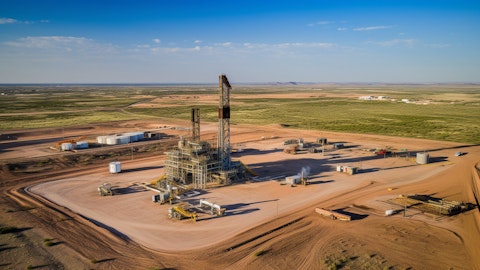Bud Brigham: Yes and I’ll just add, just a general comment. Obviously, given the rate of return on our projects, such as the Dune Express and the high-capacity trucking and our margins and our cash generation, it is a high bar. But as you can see from the Hi-Crush acquisition, that was an extremely accretive acquisition. And I am optimistic that we will have more acquisitions in the future. It’s just we don’t have anything we can point to right now.
Keith Mackey: Okay, appreciate that. And maybe if we just think about it a little bit from the customer standpoint, lots of customer consolidation happening in the Permian right now. Can you just talk about what that means for oilfield services in general and your position within the market as well?
Bud Brigham: Yes. Thank you. I’ll start and these guys may want to add to it. Scale matters. And as a former operator, we’ve appreciated that and recognized that. And you’re seeing that execution by operators to grow their scale, that enables them to drive down costs and drive up their margins and there’s a lot of leverage associated with that. And the same thing is true on the oilfield service side. And particularly, for Atlas is the largest proppant producer, the largest logistics provider. We saw, through this recent disruption, that our scale and our culture, our innovative collaborative culture and our great people enable us, despite disruptions, to be able to perform and deliver for our customers. So I think we’re benefiting from that.
And it’s important that we continue to operate as efficiently as we can to reliably service our customers. So I think Atlas is in a unique position. Nobody could have performed the way that we have through that disruption. And we’re going to continue to perform that way. I don’t know if you want to add to that.
Kyle Turlington: Yes, I mean, I think it’s — a lot of customers are looking for diversification strategy. And, I mean, Atlas is a diversification strategy. I mean, we have four dry mine locations, we got eight wet sand locations, going to nine. Obviously, with the large logistics offering, I mean, there’s not — there’s no other company out there that could provide that. And, you know, we’re going to continue to build on that to be –to continue to serve our great customers.
Bud Brigham: Yes, the redundancy, nobody can match that.
Keith Mackey: Perfect. Thanks very much. That’s it for me.
Bud Brigham: Thank you.
Operator: Our next question is from David Smith with Pickering Energy Partners. Please proceed.
David Smith: Hi, good morning and thank you.
Bud Brigham: Good morning.
David Smith: I’ll just — I wanted to reiterate that congratulations on the incredible response to the fire as well as the hiring of Blake McCarthy. I thought it was really impressive that over half of your Q1 volumes were delivered with your own logistics. And sorry if I missed this detail. Have you talked about what you’re seeing for your average delivery volumes in the areas to be served by Dune Express? And if you’re seeing a greater mix of double and triple trailer deliveries. But really, how do average volumes per delivery compared to where you would expect them to be once Dune Express is fully online?
Bud Brigham: Go ahead, Chris.
Chris Scholla: Yes, I think from a total volumes perspective, the Dune Express capacity, with current average monthly volumes per crew today, we’ll need to be up around that 20 to 21 crews is what we’re looking at. As you’ve seen us, right, our business looking at the Last Mile side of things, specifically in the Delaware, I mean, we’ve grown somewhere in that 8 to 10 times range in the last 24 months. So our ability to achieve an additional 7 crews — 7, 8 crews out there, we see as highly probable as we continue down that pathway.
David Smith: Yes, I absolutely appreciate it. And maybe I asked the question the wrong way, but when thinking about, you’ve got the 120 trucks, right, and total delivery capability is really going to be a function of turns per day and average volumes per trip to the well site. So I was more thinking about that average volumes per trip to the well site. If customers are taking real advantage of the ability to deliver two or three trailers at a time.
Chris Scholla: So I guess you’re asking the multi-trailer success?
David Smith: Yes.
John Turner: So from a multi-trailer side of this, we’ve recently opened up an additional depot up in Polygon 6, which will be where the end of the Dune Express lies. Opening up pretty significant volume for us there. We’ve now run double and triple trailers with five customers out there. And we continue to see our average payloads go up. I believe with our first triple trailer starting out April 5 of last year to where we are today with now two depots, looking to open a third one here shortly, I think our customers that are utilizing them, we’ve even had customers look and modify their completions program to optimize the use of double and triple trailers. So while two years ago, people thought this was a very creative, but would never happen idea, it was the same thing with the Dune Express, right?
And once our customers see the efficiencies that they gain on location, minimizing the trucks and also getting those trucks off the public road, we’ve had nothing but success in there and also in recent conversations with folks to even optimize the pad layout and sizings around double trailer. So I think those type of actions and conversations for our customers really show where this is heading with the multi-trailer operations.
David Smith: That’s great color. Thank you for the update.
Operator: Our next question is from Neil Mehta with Goldman Sachs. Please proceed.
Neil Mehta: Yes, thanks for this. And, Bud, thanks for your comments. John, congrats on your promotion. And, Blake, you as well. My first question is just around the Dune Express, as we think about construction, we’re getting really close to coming into service. So what are the last kind of gating items? And can you give us a sense of your confidence interval around executing some of the last bottlenecks that might exist?
John Turner: Obviously, the Dune Express construction has been moving along. We have over 200 people out there working on the construction of that. The fire itself is not going to impact the Dune Express construction at all. In fact, I think it’s going to enable our crews to install the tie into the plant more quickly. As far as the next bottlenecks, I mean, I think the next milestones for us is going to be starting to commission — to start the commissioning process, which is supposed to start at the end of the third quarter, early fourth quarter. And we’ll be, obviously won’t be selling any sand off at Dune Express for a while, but the commissioning of that process is going to take another three, up until the end of the fourth quarter to get —
Bud Brigham: We’ll talk a little bit, John, about what that commissioning is that we’ll be running.
John Turner: Yes, I mean, it’s just — with the commissioning process is just getting up the sand. You’re not really running any sand down the belts, but what you’re doing is you’re running those belts to make sure that they — the belts are tracking, to make sure that they’re working in order, making sure that you’ve got all the bugs worked out. But as far as the — I mean, as far as the kind of the gating items, we’ve ordered all the equipment. We’ve got all the folks out there working on the — working on the construction. We’ve already done our two major overhead road crossings, some major overhead crossings. We still have some cattle and wildlife crossings to go and some leash road crossings to go, but everything is moving along as expected on the Dune Express.
Neil Mehta: Thanks, John. And then you alluded to this free cash flow inflection which we see in 2025 as well and the potential to return more capital to shareholders. Do you have a preference in terms of doing it through the dividend versus buybacks or is it price dependent? Just talk about the framework of how the board is thinking about the return of capital?
John Turner: Right now, we’re really focused on returning cash to our investors. We think that paying that dividend is obviously something that we’re really focused on as an organization. I would say stock buybacks is not something that we’ve really discussed. That’s something that we will likely be putting into a formal plan here in the next — before we get to the end of this year. But right now, what we’re focused is really at returning cash to our shareholders.


